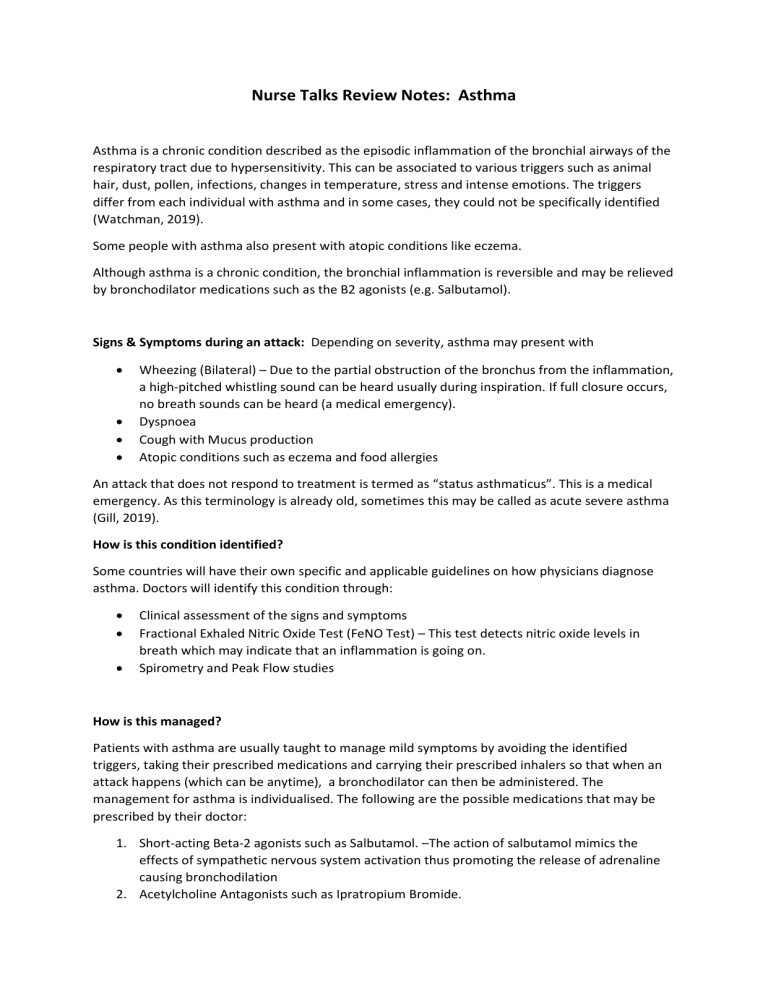
Nurse Talks Review Notes: Asthma Asthma is a chronic condition described as the episodic inflammation of the bronchial airways of the respiratory tract due to hypersensitivity. This can be associated to various triggers such as animal hair, dust, pollen, infections, changes in temperature, stress and intense emotions. The triggers differ from each individual with asthma and in some cases, they could not be specifically identified (Watchman, 2019). Some people with asthma also present with atopic conditions like eczema. Although asthma is a chronic condition, the bronchial inflammation is reversible and may be relieved by bronchodilator medications such as the B2 agonists (e.g. Salbutamol). Signs & Symptoms during an attack: Depending on severity, asthma may present with Wheezing (Bilateral) – Due to the partial obstruction of the bronchus from the inflammation, a high-pitched whistling sound can be heard usually during inspiration. If full closure occurs, no breath sounds can be heard (a medical emergency). Dyspnoea Cough with Mucus production Atopic conditions such as eczema and food allergies An attack that does not respond to treatment is termed as “status asthmaticus”. This is a medical emergency. As this terminology is already old, sometimes this may be called as acute severe asthma (Gill, 2019). How is this condition identified? Some countries will have their own specific and applicable guidelines on how physicians diagnose asthma. Doctors will identify this condition through: Clinical assessment of the signs and symptoms Fractional Exhaled Nitric Oxide Test (FeNO Test) – This test detects nitric oxide levels in breath which may indicate that an inflammation is going on. Spirometry and Peak Flow studies How is this managed? Patients with asthma are usually taught to manage mild symptoms by avoiding the identified triggers, taking their prescribed medications and carrying their prescribed inhalers so that when an attack happens (which can be anytime), a bronchodilator can then be administered. The management for asthma is individualised. The following are the possible medications that may be prescribed by their doctor: 1. Short-acting Beta-2 agonists such as Salbutamol. –The action of salbutamol mimics the effects of sympathetic nervous system activation thus promoting the release of adrenaline causing bronchodilation 2. Acetylcholine Antagonists such as Ipratropium Bromide. 3. Inhaled Corticosteroids (e.g. Beclomethasone) – used in the short term due to steroid side effects such as increased susceptibility to infections 4. Leukotriene Receptor Antagonist (e.g. Montelukast) – Leukotrienes are inflammatory molecules produced by the immune system. Leukotriene Receptor Antagonists inhibit the synthesis of Leukotrienes. 5. Aminophylline – This is a bronchodilator and has a narrow therapeutic range. The clinician must monitor the levels closely when this is administered. 6. Adrenaline / Epinephrine Oxygen therapy may be required for respiratory symptoms that present with low oxygen levels. The management of an asthmatic attack is aimed at relieving the patient with their symptoms and keeping them comfortable. Once stable, the goal should then be in preventing further attacks and exacerbations in the future as possible. References: Gill, K., (2019). Recognizing and Treating Status Asthmaticus. [online] Healthline. Available at: <https://www.healthline.com/health/status-asthmaticus> [Accessed 31 March 2021]. National HealtH Service, 2018. Asthma - Diagnosis. [online] nhs.uk. Available at: <https://www.nhs.uk/conditions/asthma/diagnosis/> [Accessed 31 March 2021]. Watchman, T., (2019). Asthma. [podcast] Zero To Finals. Available at: <https://zerotofinals.com/medicine/respiratory/asthma/> [Accessed 31 March 2021].



